Evaluating Leadership Strategy and Change in Sainsbury's-Argos Deal
VerifiedAdded on 2023/06/11
|15
|5765
|380
Essay
AI Summary
This essay explores leadership strategies and change management within the context of Sainsbury's acquisition of Argos in 2016. It begins by introducing the situation, noting the initial positive performance of Argos following the acquisition, followed by an overall decline in Sainsbury's sales. Various leadership approaches, including autocratic, transactional, bureaucratic, charismatic, transformational, coaching, democratic, collaborative, and servant leadership, are analyzed for their applicability to the case. The essay discusses the pros and cons of each approach, considering how they might impact employee motivation, innovation, and organizational effectiveness within Sainsbury's. The analysis aims to identify appropriate leadership strategies that could have facilitated a more successful integration and adaptation to changing market dynamics.
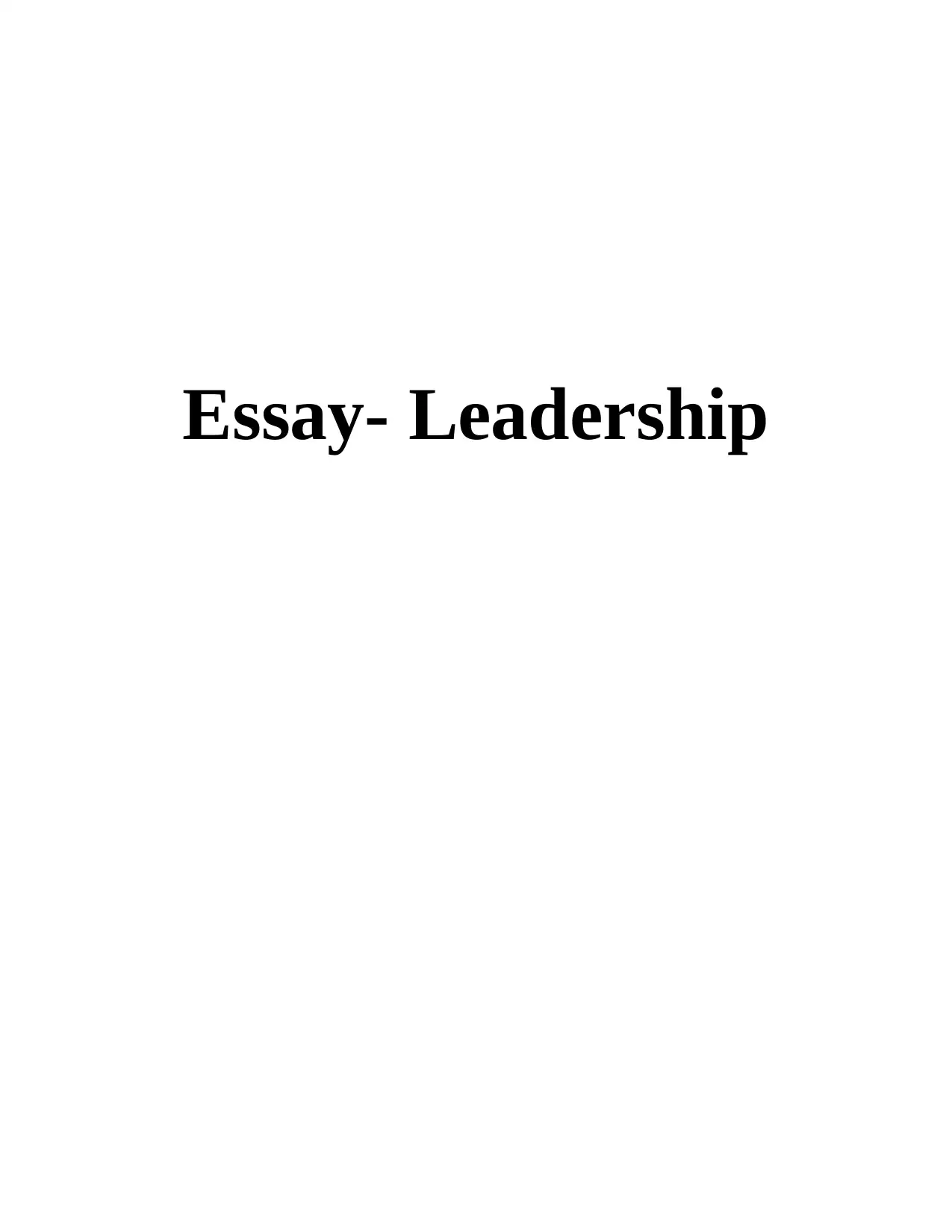
Essay- Leadership
Paraphrase This Document
Need a fresh take? Get an instant paraphrase of this document with our AI Paraphraser
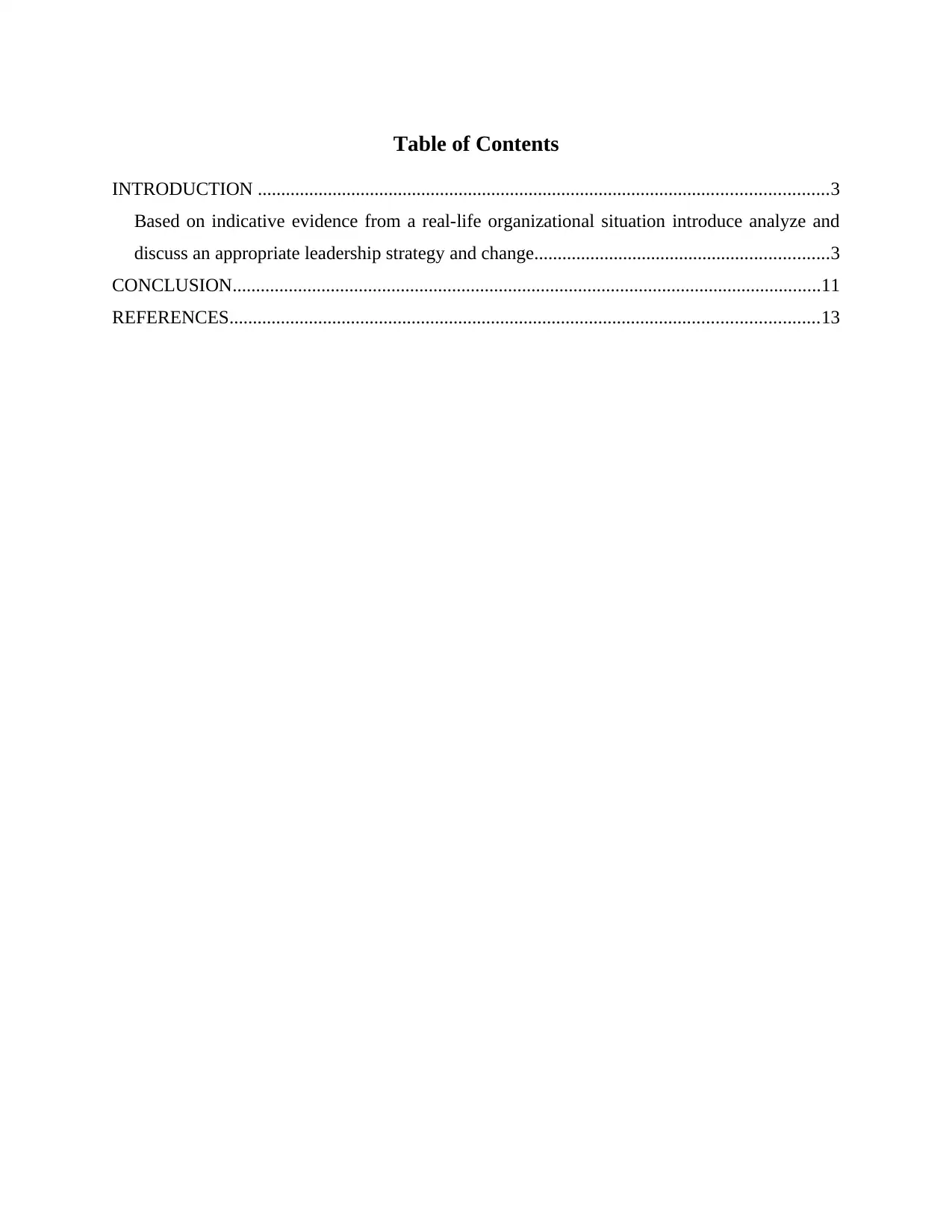
Table of Contents
INTRODUCTION ..........................................................................................................................3
Based on indicative evidence from a real-life organizational situation introduce analyze and
discuss an appropriate leadership strategy and change...............................................................3
CONCLUSION..............................................................................................................................11
REFERENCES..............................................................................................................................13
INTRODUCTION ..........................................................................................................................3
Based on indicative evidence from a real-life organizational situation introduce analyze and
discuss an appropriate leadership strategy and change...............................................................3
CONCLUSION..............................................................................................................................11
REFERENCES..............................................................................................................................13
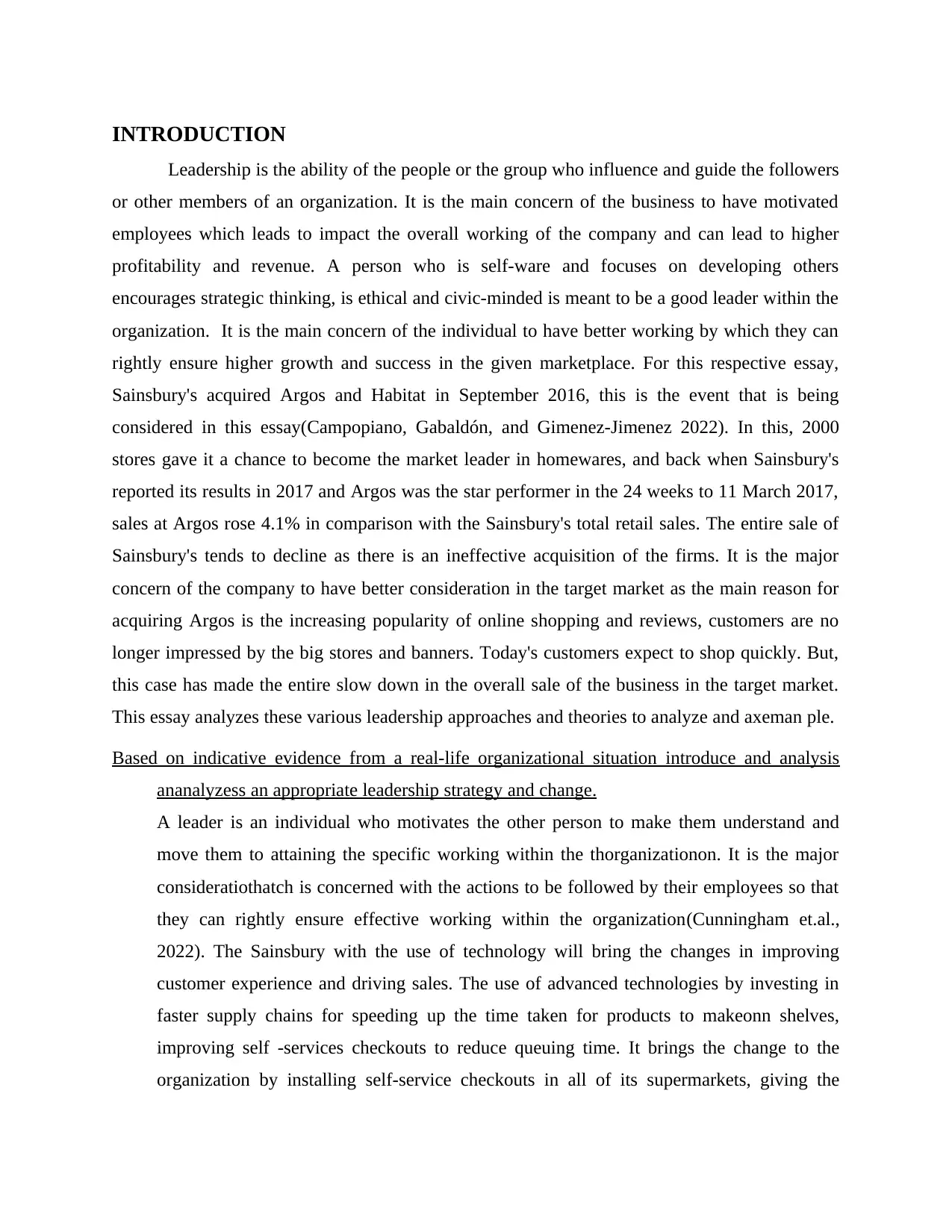
INTRODUCTION
Leadership is the ability of the people or the group who influence and guide the followers
or other members of an organization. It is the main concern of the business to have motivated
employees which leads to impact the overall working of the company and can lead to higher
profitability and revenue. A person who is self-ware and focuses on developing others
encourages strategic thinking, is ethical and civic-minded is meant to be a good leader within the
organization. It is the main concern of the individual to have better working by which they can
rightly ensure higher growth and success in the given marketplace. For this respective essay,
Sainsbury's acquired Argos and Habitat in September 2016, this is the event that is being
considered in this essay(Campopiano, Gabaldón, and Gimenez-Jimenez 2022). In this, 2000
stores gave it a chance to become the market leader in homewares, and back when Sainsbury's
reported its results in 2017 and Argos was the star performer in the 24 weeks to 11 March 2017,
sales at Argos rose 4.1% in comparison with the Sainsbury's total retail sales. The entire sale of
Sainsbury's tends to decline as there is an ineffective acquisition of the firms. It is the major
concern of the company to have better consideration in the target market as the main reason for
acquiring Argos is the increasing popularity of online shopping and reviews, customers are no
longer impressed by the big stores and banners. Today's customers expect to shop quickly. But,
this case has made the entire slow down in the overall sale of the business in the target market.
This essay analyzes these various leadership approaches and theories to analyze and axeman ple.
Based on indicative evidence from a real-life organizational situation introduce and analysis
ananalyzess an appropriate leadership strategy and change.
A leader is an individual who motivates the other person to make them understand and
move them to attaining the specific working within the thorganizationon. It is the major
consideratiothatch is concerned with the actions to be followed by their employees so that
they can rightly ensure effective working within the organization(Cunningham et.al.,
2022). The Sainsbury with the use of technology will bring the changes in improving
customer experience and driving sales. The use of advanced technologies by investing in
faster supply chains for speeding up the time taken for products to makeonn shelves,
improving self -services checkouts to reduce queuing time. It brings the change to the
organization by installing self-service checkouts in all of its supermarkets, giving the
Leadership is the ability of the people or the group who influence and guide the followers
or other members of an organization. It is the main concern of the business to have motivated
employees which leads to impact the overall working of the company and can lead to higher
profitability and revenue. A person who is self-ware and focuses on developing others
encourages strategic thinking, is ethical and civic-minded is meant to be a good leader within the
organization. It is the main concern of the individual to have better working by which they can
rightly ensure higher growth and success in the given marketplace. For this respective essay,
Sainsbury's acquired Argos and Habitat in September 2016, this is the event that is being
considered in this essay(Campopiano, Gabaldón, and Gimenez-Jimenez 2022). In this, 2000
stores gave it a chance to become the market leader in homewares, and back when Sainsbury's
reported its results in 2017 and Argos was the star performer in the 24 weeks to 11 March 2017,
sales at Argos rose 4.1% in comparison with the Sainsbury's total retail sales. The entire sale of
Sainsbury's tends to decline as there is an ineffective acquisition of the firms. It is the major
concern of the company to have better consideration in the target market as the main reason for
acquiring Argos is the increasing popularity of online shopping and reviews, customers are no
longer impressed by the big stores and banners. Today's customers expect to shop quickly. But,
this case has made the entire slow down in the overall sale of the business in the target market.
This essay analyzes these various leadership approaches and theories to analyze and axeman ple.
Based on indicative evidence from a real-life organizational situation introduce and analysis
ananalyzess an appropriate leadership strategy and change.
A leader is an individual who motivates the other person to make them understand and
move them to attaining the specific working within the thorganizationon. It is the major
consideratiothatch is concerned with the actions to be followed by their employees so that
they can rightly ensure effective working within the organization(Cunningham et.al.,
2022). The Sainsbury with the use of technology will bring the changes in improving
customer experience and driving sales. The use of advanced technologies by investing in
faster supply chains for speeding up the time taken for products to makeonn shelves,
improving self -services checkouts to reduce queuing time. It brings the change to the
organization by installing self-service checkouts in all of its supermarkets, giving the
⊘ This is a preview!⊘
Do you want full access?
Subscribe today to unlock all pages.

Trusted by 1+ million students worldwide
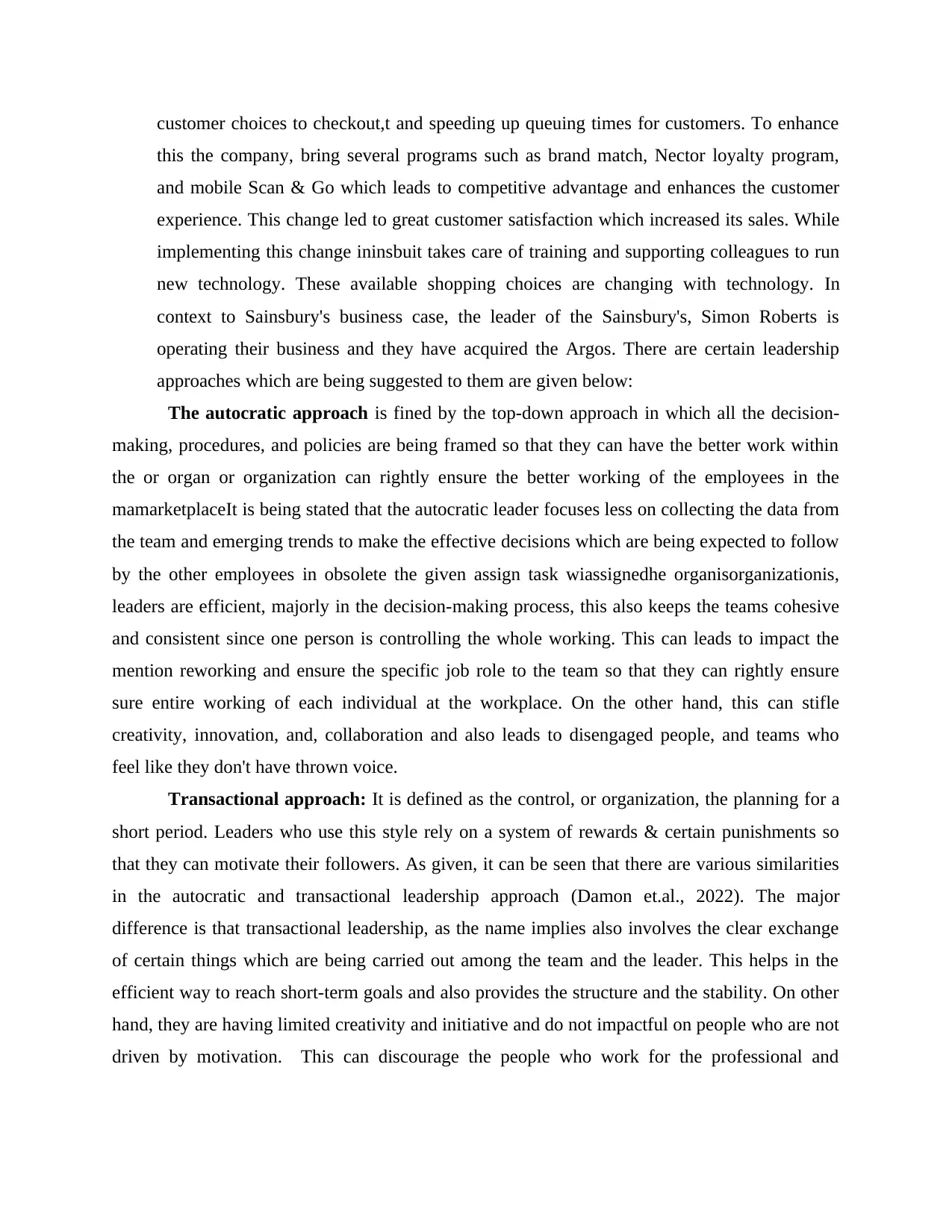
customer choices to checkout,t and speeding up queuing times for customers. To enhance
this the company, bring several programs such as brand match, Nector loyalty program,
and mobile Scan & Go which leads to competitive advantage and enhances the customer
experience. This change led to great customer satisfaction which increased its sales. While
implementing this change ininsbuit takes care of training and supporting colleagues to run
new technology. These available shopping choices are changing with technology. In
context to Sainsbury's business case, the leader of the Sainsbury's, Simon Roberts is
operating their business and they have acquired the Argos. There are certain leadership
approaches which are being suggested to them are given below:
The autocratic approach is fined by the top-down approach in which all the decision-
making, procedures, and policies are being framed so that they can have the better work within
the or organ or organization can rightly ensure the better working of the employees in the
mamarketplaceIt is being stated that the autocratic leader focuses less on collecting the data from
the team and emerging trends to make the effective decisions which are being expected to follow
by the other employees in obsolete the given assign task wiassignedhe organisorganizationis,
leaders are efficient, majorly in the decision-making process, this also keeps the teams cohesive
and consistent since one person is controlling the whole working. This can leads to impact the
mention reworking and ensure the specific job role to the team so that they can rightly ensure
sure entire working of each individual at the workplace. On the other hand, this can stifle
creativity, innovation, and, collaboration and also leads to disengaged people, and teams who
feel like they don't have thrown voice.
Transactional approach: It is defined as the control, or organization, the planning for a
short period. Leaders who use this style rely on a system of rewards & certain punishments so
that they can motivate their followers. As given, it can be seen that there are various similarities
in the autocratic and transactional leadership approach (Damon et.al., 2022). The major
difference is that transactional leadership, as the name implies also involves the clear exchange
of certain things which are being carried out among the team and the leader. This helps in the
efficient way to reach short-term goals and also provides the structure and the stability. On other
hand, they are having limited creativity and initiative and do not impactful on people who are not
driven by motivation. This can discourage the people who work for the professional and
this the company, bring several programs such as brand match, Nector loyalty program,
and mobile Scan & Go which leads to competitive advantage and enhances the customer
experience. This change led to great customer satisfaction which increased its sales. While
implementing this change ininsbuit takes care of training and supporting colleagues to run
new technology. These available shopping choices are changing with technology. In
context to Sainsbury's business case, the leader of the Sainsbury's, Simon Roberts is
operating their business and they have acquired the Argos. There are certain leadership
approaches which are being suggested to them are given below:
The autocratic approach is fined by the top-down approach in which all the decision-
making, procedures, and policies are being framed so that they can have the better work within
the or organ or organization can rightly ensure the better working of the employees in the
mamarketplaceIt is being stated that the autocratic leader focuses less on collecting the data from
the team and emerging trends to make the effective decisions which are being expected to follow
by the other employees in obsolete the given assign task wiassignedhe organisorganizationis,
leaders are efficient, majorly in the decision-making process, this also keeps the teams cohesive
and consistent since one person is controlling the whole working. This can leads to impact the
mention reworking and ensure the specific job role to the team so that they can rightly ensure
sure entire working of each individual at the workplace. On the other hand, this can stifle
creativity, innovation, and, collaboration and also leads to disengaged people, and teams who
feel like they don't have thrown voice.
Transactional approach: It is defined as the control, or organization, the planning for a
short period. Leaders who use this style rely on a system of rewards & certain punishments so
that they can motivate their followers. As given, it can be seen that there are various similarities
in the autocratic and transactional leadership approach (Damon et.al., 2022). The major
difference is that transactional leadership, as the name implies also involves the clear exchange
of certain things which are being carried out among the team and the leader. This helps in the
efficient way to reach short-term goals and also provides the structure and the stability. On other
hand, they are having limited creativity and initiative and do not impactful on people who are not
driven by motivation. This can discourage the people who work for the professional and
Paraphrase This Document
Need a fresh take? Get an instant paraphrase of this document with our AI Paraphraser
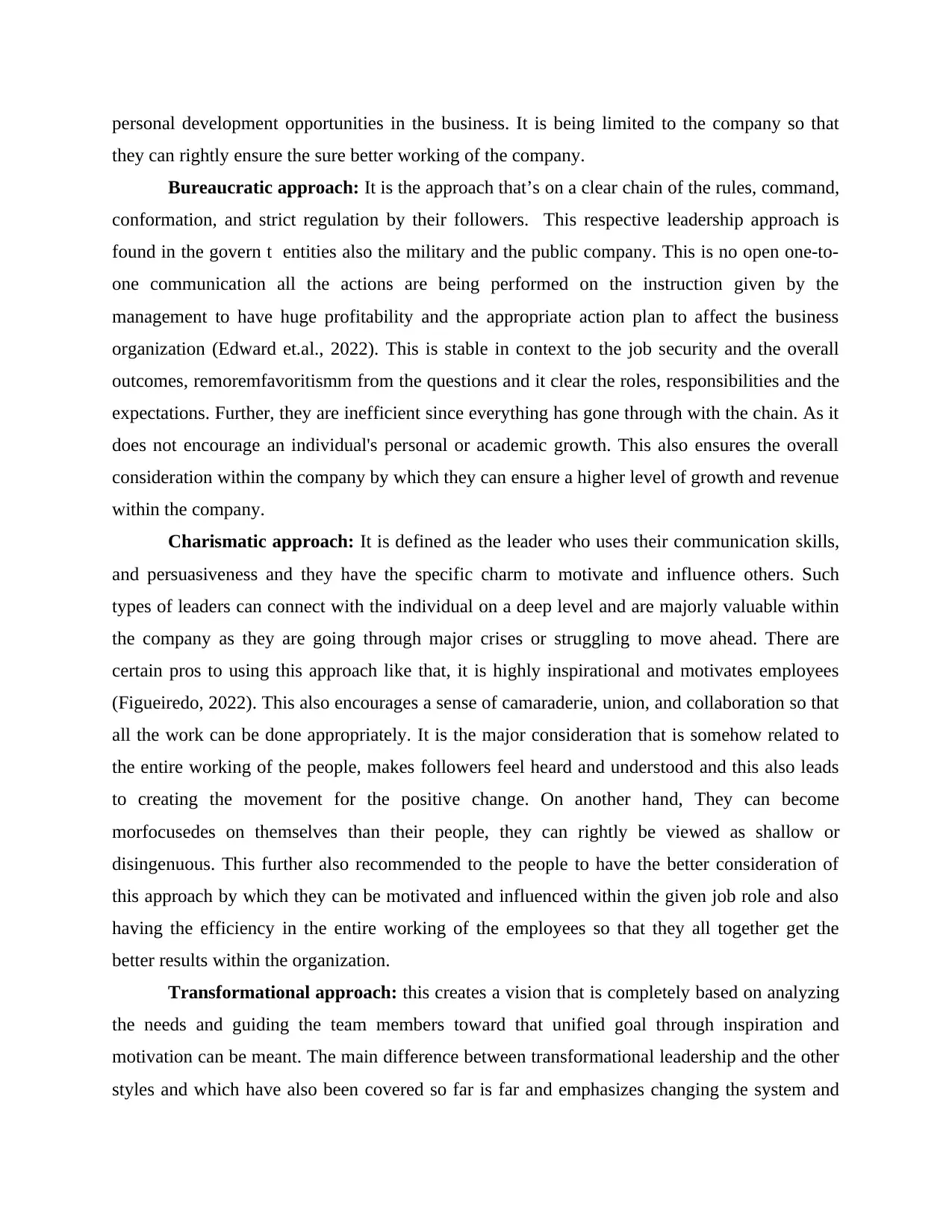
personal development opportunities in the business. It is being limited to the company so that
they can rightly ensure the sure better working of the company.
Bureaucratic approach: It is the approach that’s on a clear chain of the rules, command,
conformation, and strict regulation by their followers. This respective leadership approach is
found in the govern t entities also the military and the public company. This is no open one-to-
one communication all the actions are being performed on the instruction given by the
management to have huge profitability and the appropriate action plan to affect the business
organization (Edward et.al., 2022). This is stable in context to the job security and the overall
outcomes, remoremfavoritismm from the questions and it clear the roles, responsibilities and the
expectations. Further, they are inefficient since everything has gone through with the chain. As it
does not encourage an individual's personal or academic growth. This also ensures the overall
consideration within the company by which they can ensure a higher level of growth and revenue
within the company.
Charismatic approach: It is defined as the leader who uses their communication skills,
and persuasiveness and they have the specific charm to motivate and influence others. Such
types of leaders can connect with the individual on a deep level and are majorly valuable within
the company as they are going through major crises or struggling to move ahead. There are
certain pros to using this approach like that, it is highly inspirational and motivates employees
(Figueiredo, 2022). This also encourages a sense of camaraderie, union, and collaboration so that
all the work can be done appropriately. It is the major consideration that is somehow related to
the entire working of the people, makes followers feel heard and understood and this also leads
to creating the movement for the positive change. On another hand, They can become
morfocusedes on themselves than their people, they can rightly be viewed as shallow or
disingenuous. This further also recommended to the people to have the better consideration of
this approach by which they can be motivated and influenced within the given job role and also
having the efficiency in the entire working of the employees so that they all together get the
better results within the organization.
Transformational approach: this creates a vision that is completely based on analyzing
the needs and guiding the team members toward that unified goal through inspiration and
motivation can be meant. The main difference between transformational leadership and the other
styles and which have also been covered so far is far and emphasizes changing the system and
they can rightly ensure the sure better working of the company.
Bureaucratic approach: It is the approach that’s on a clear chain of the rules, command,
conformation, and strict regulation by their followers. This respective leadership approach is
found in the govern t entities also the military and the public company. This is no open one-to-
one communication all the actions are being performed on the instruction given by the
management to have huge profitability and the appropriate action plan to affect the business
organization (Edward et.al., 2022). This is stable in context to the job security and the overall
outcomes, remoremfavoritismm from the questions and it clear the roles, responsibilities and the
expectations. Further, they are inefficient since everything has gone through with the chain. As it
does not encourage an individual's personal or academic growth. This also ensures the overall
consideration within the company by which they can ensure a higher level of growth and revenue
within the company.
Charismatic approach: It is defined as the leader who uses their communication skills,
and persuasiveness and they have the specific charm to motivate and influence others. Such
types of leaders can connect with the individual on a deep level and are majorly valuable within
the company as they are going through major crises or struggling to move ahead. There are
certain pros to using this approach like that, it is highly inspirational and motivates employees
(Figueiredo, 2022). This also encourages a sense of camaraderie, union, and collaboration so that
all the work can be done appropriately. It is the major consideration that is somehow related to
the entire working of the people, makes followers feel heard and understood and this also leads
to creating the movement for the positive change. On another hand, They can become
morfocusedes on themselves than their people, they can rightly be viewed as shallow or
disingenuous. This further also recommended to the people to have the better consideration of
this approach by which they can be motivated and influenced within the given job role and also
having the efficiency in the entire working of the employees so that they all together get the
better results within the organization.
Transformational approach: this creates a vision that is completely based on analyzing
the needs and guiding the team members toward that unified goal through inspiration and
motivation can be meant. The main difference between transformational leadership and the other
styles and which have also been covered so far is far and emphasizes changing the system and
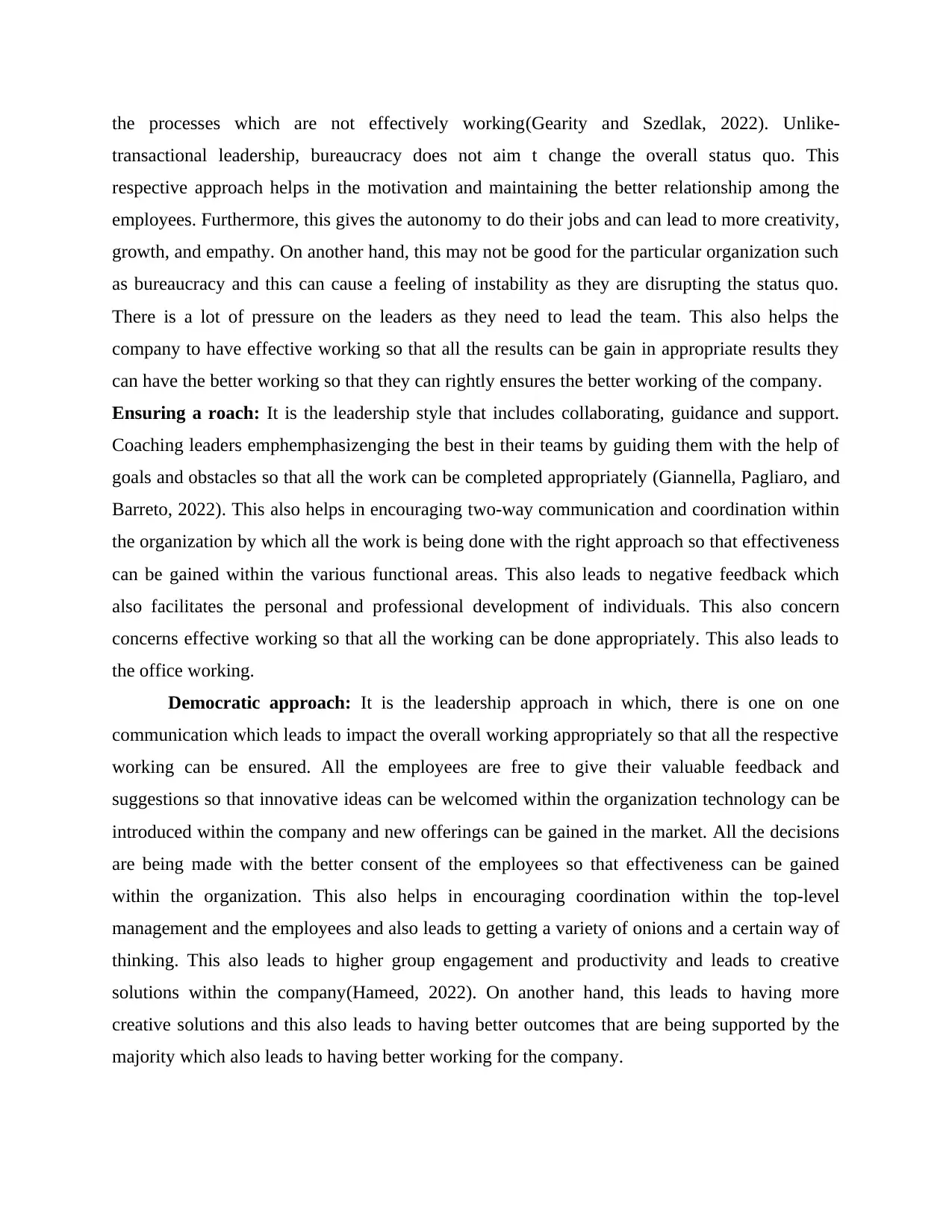
the processes which are not effectively working(Gearity and Szedlak, 2022). Unlike-
transactional leadership, bureaucracy does not aim t change the overall status quo. This
respective approach helps in the motivation and maintaining the better relationship among the
employees. Furthermore, this gives the autonomy to do their jobs and can lead to more creativity,
growth, and empathy. On another hand, this may not be good for the particular organization such
as bureaucracy and this can cause a feeling of instability as they are disrupting the status quo.
There is a lot of pressure on the leaders as they need to lead the team. This also helps the
company to have effective working so that all the results can be gain in appropriate results they
can have the better working so that they can rightly ensures the better working of the company.
Ensuring a roach: It is the leadership style that includes collaborating, guidance and support.
Coaching leaders emphemphasizenging the best in their teams by guiding them with the help of
goals and obstacles so that all the work can be completed appropriately (Giannella, Pagliaro, and
Barreto, 2022). This also helps in encouraging two-way communication and coordination within
the organization by which all the work is being done with the right approach so that effectiveness
can be gained within the various functional areas. This also leads to negative feedback which
also facilitates the personal and professional development of individuals. This also concern
concerns effective working so that all the working can be done appropriately. This also leads to
the office working.
Democratic approach: It is the leadership approach in which, there is one on one
communication which leads to impact the overall working appropriately so that all the respective
working can be ensured. All the employees are free to give their valuable feedback and
suggestions so that innovative ideas can be welcomed within the organization technology can be
introduced within the company and new offerings can be gained in the market. All the decisions
are being made with the better consent of the employees so that effectiveness can be gained
within the organization. This also helps in encouraging coordination within the top-level
management and the employees and also leads to getting a variety of onions and a certain way of
thinking. This also leads to higher group engagement and productivity and leads to creative
solutions within the company(Hameed, 2022). On another hand, this leads to having more
creative solutions and this also leads to having better outcomes that are being supported by the
majority which also leads to having better working for the company.
transactional leadership, bureaucracy does not aim t change the overall status quo. This
respective approach helps in the motivation and maintaining the better relationship among the
employees. Furthermore, this gives the autonomy to do their jobs and can lead to more creativity,
growth, and empathy. On another hand, this may not be good for the particular organization such
as bureaucracy and this can cause a feeling of instability as they are disrupting the status quo.
There is a lot of pressure on the leaders as they need to lead the team. This also helps the
company to have effective working so that all the results can be gain in appropriate results they
can have the better working so that they can rightly ensures the better working of the company.
Ensuring a roach: It is the leadership style that includes collaborating, guidance and support.
Coaching leaders emphemphasizenging the best in their teams by guiding them with the help of
goals and obstacles so that all the work can be completed appropriately (Giannella, Pagliaro, and
Barreto, 2022). This also helps in encouraging two-way communication and coordination within
the organization by which all the work is being done with the right approach so that effectiveness
can be gained within the various functional areas. This also leads to negative feedback which
also facilitates the personal and professional development of individuals. This also concern
concerns effective working so that all the working can be done appropriately. This also leads to
the office working.
Democratic approach: It is the leadership approach in which, there is one on one
communication which leads to impact the overall working appropriately so that all the respective
working can be ensured. All the employees are free to give their valuable feedback and
suggestions so that innovative ideas can be welcomed within the organization technology can be
introduced within the company and new offerings can be gained in the market. All the decisions
are being made with the better consent of the employees so that effectiveness can be gained
within the organization. This also helps in encouraging coordination within the top-level
management and the employees and also leads to getting a variety of onions and a certain way of
thinking. This also leads to higher group engagement and productivity and leads to creative
solutions within the company(Hameed, 2022). On another hand, this leads to having more
creative solutions and this also leads to having better outcomes that are being supported by the
majority which also leads to having better working for the company.
⊘ This is a preview!⊘
Do you want full access?
Subscribe today to unlock all pages.

Trusted by 1+ million students worldwide
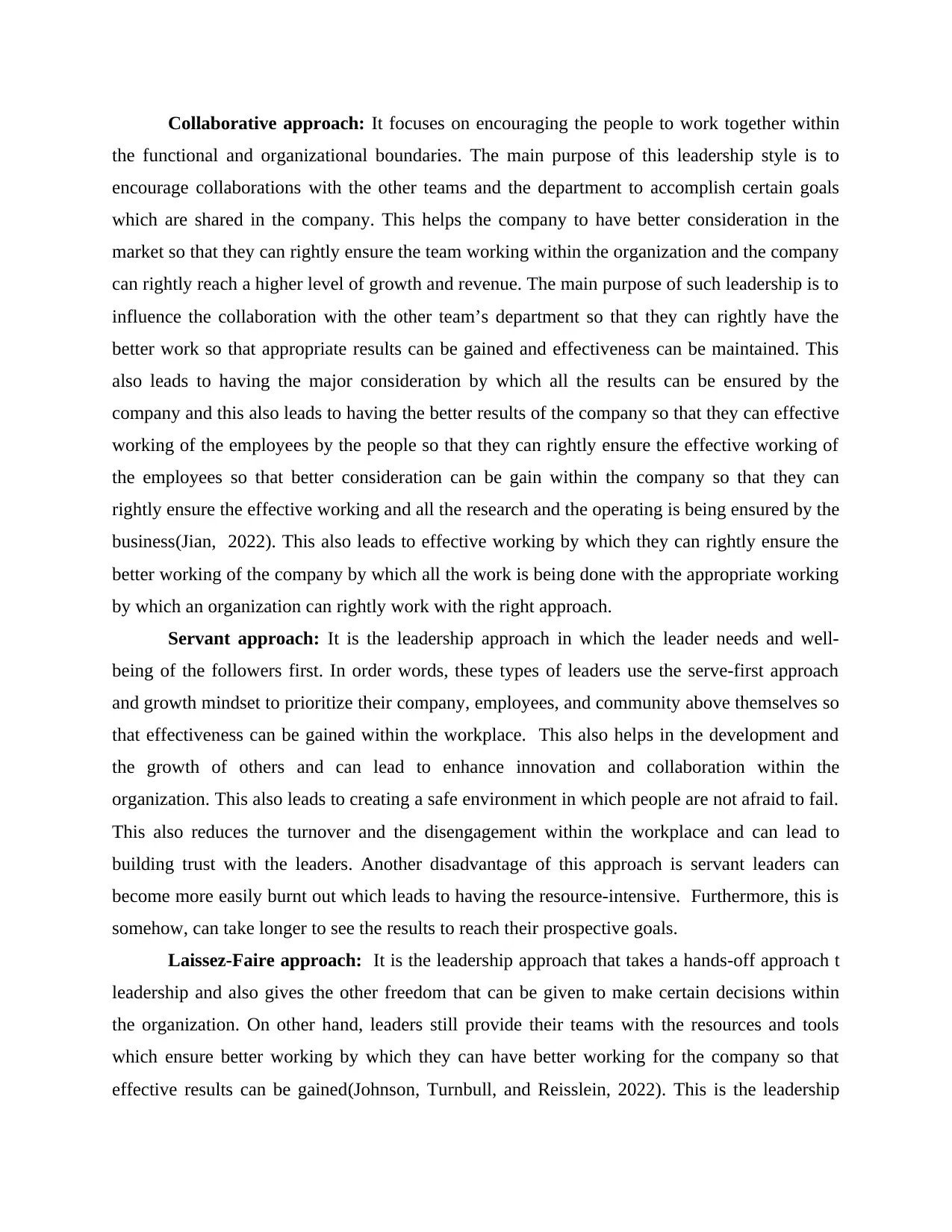
Collaborative approach: It focuses on encouraging the people to work together within
the functional and organizational boundaries. The main purpose of this leadership style is to
encourage collaborations with the other teams and the department to accomplish certain goals
which are shared in the company. This helps the company to have better consideration in the
market so that they can rightly ensure the team working within the organization and the company
can rightly reach a higher level of growth and revenue. The main purpose of such leadership is to
influence the collaboration with the other team’s department so that they can rightly have the
better work so that appropriate results can be gained and effectiveness can be maintained. This
also leads to having the major consideration by which all the results can be ensured by the
company and this also leads to having the better results of the company so that they can effective
working of the employees by the people so that they can rightly ensure the effective working of
the employees so that better consideration can be gain within the company so that they can
rightly ensure the effective working and all the research and the operating is being ensured by the
business(Jian, 2022). This also leads to effective working by which they can rightly ensure the
better working of the company by which all the work is being done with the appropriate working
by which an organization can rightly work with the right approach.
Servant approach: It is the leadership approach in which the leader needs and well-
being of the followers first. In order words, these types of leaders use the serve-first approach
and growth mindset to prioritize their company, employees, and community above themselves so
that effectiveness can be gained within the workplace. This also helps in the development and
the growth of others and can lead to enhance innovation and collaboration within the
organization. This also leads to creating a safe environment in which people are not afraid to fail.
This also reduces the turnover and the disengagement within the workplace and can lead to
building trust with the leaders. Another disadvantage of this approach is servant leaders can
become more easily burnt out which leads to having the resource-intensive. Furthermore, this is
somehow, can take longer to see the results to reach their prospective goals.
Laissez-Faire approach: It is the leadership approach that takes a hands-off approach t
leadership and also gives the other freedom that can be given to make certain decisions within
the organization. On other hand, leaders still provide their teams with the resources and tools
which ensure better working by which they can have better working for the company so that
effective results can be gained(Johnson, Turnbull, and Reisslein, 2022). This is the leadership
the functional and organizational boundaries. The main purpose of this leadership style is to
encourage collaborations with the other teams and the department to accomplish certain goals
which are shared in the company. This helps the company to have better consideration in the
market so that they can rightly ensure the team working within the organization and the company
can rightly reach a higher level of growth and revenue. The main purpose of such leadership is to
influence the collaboration with the other team’s department so that they can rightly have the
better work so that appropriate results can be gained and effectiveness can be maintained. This
also leads to having the major consideration by which all the results can be ensured by the
company and this also leads to having the better results of the company so that they can effective
working of the employees by the people so that they can rightly ensure the effective working of
the employees so that better consideration can be gain within the company so that they can
rightly ensure the effective working and all the research and the operating is being ensured by the
business(Jian, 2022). This also leads to effective working by which they can rightly ensure the
better working of the company by which all the work is being done with the appropriate working
by which an organization can rightly work with the right approach.
Servant approach: It is the leadership approach in which the leader needs and well-
being of the followers first. In order words, these types of leaders use the serve-first approach
and growth mindset to prioritize their company, employees, and community above themselves so
that effectiveness can be gained within the workplace. This also helps in the development and
the growth of others and can lead to enhance innovation and collaboration within the
organization. This also leads to creating a safe environment in which people are not afraid to fail.
This also reduces the turnover and the disengagement within the workplace and can lead to
building trust with the leaders. Another disadvantage of this approach is servant leaders can
become more easily burnt out which leads to having the resource-intensive. Furthermore, this is
somehow, can take longer to see the results to reach their prospective goals.
Laissez-Faire approach: It is the leadership approach that takes a hands-off approach t
leadership and also gives the other freedom that can be given to make certain decisions within
the organization. On other hand, leaders still provide their teams with the resources and tools
which ensure better working by which they can have better working for the company so that
effective results can be gained(Johnson, Turnbull, and Reisslein, 2022). This is the leadership
Paraphrase This Document
Need a fresh take? Get an instant paraphrase of this document with our AI Paraphraser
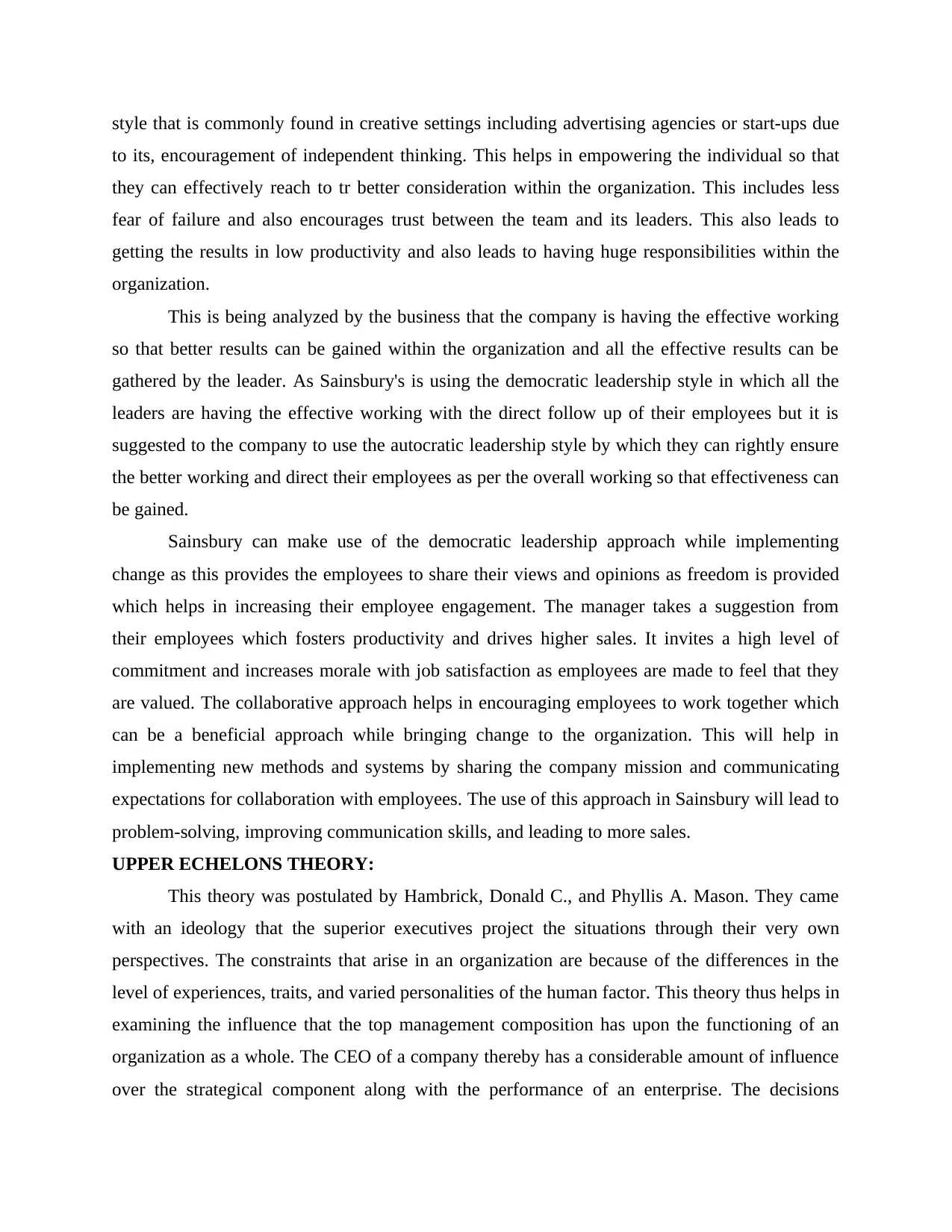
style that is commonly found in creative settings including advertising agencies or start-ups due
to its, encouragement of independent thinking. This helps in empowering the individual so that
they can effectively reach to tr better consideration within the organization. This includes less
fear of failure and also encourages trust between the team and its leaders. This also leads to
getting the results in low productivity and also leads to having huge responsibilities within the
organization.
This is being analyzed by the business that the company is having the effective working
so that better results can be gained within the organization and all the effective results can be
gathered by the leader. As Sainsbury's is using the democratic leadership style in which all the
leaders are having the effective working with the direct follow up of their employees but it is
suggested to the company to use the autocratic leadership style by which they can rightly ensure
the better working and direct their employees as per the overall working so that effectiveness can
be gained.
Sainsbury can make use of the democratic leadership approach while implementing
change as this provides the employees to share their views and opinions as freedom is provided
which helps in increasing their employee engagement. The manager takes a suggestion from
their employees which fosters productivity and drives higher sales. It invites a high level of
commitment and increases morale with job satisfaction as employees are made to feel that they
are valued. The collaborative approach helps in encouraging employees to work together which
can be a beneficial approach while bringing change to the organization. This will help in
implementing new methods and systems by sharing the company mission and communicating
expectations for collaboration with employees. The use of this approach in Sainsbury will lead to
problem-solving, improving communication skills, and leading to more sales.
UPPER ECHELONS THEORY:
This theory was postulated by Hambrick, Donald C., and Phyllis A. Mason. They came
with an ideology that the superior executives project the situations through their very own
perspectives. The constraints that arise in an organization are because of the differences in the
level of experiences, traits, and varied personalities of the human factor. This theory thus helps in
examining the influence that the top management composition has upon the functioning of an
organization as a whole. The CEO of a company thereby has a considerable amount of influence
over the strategical component along with the performance of an enterprise. The decisions
to its, encouragement of independent thinking. This helps in empowering the individual so that
they can effectively reach to tr better consideration within the organization. This includes less
fear of failure and also encourages trust between the team and its leaders. This also leads to
getting the results in low productivity and also leads to having huge responsibilities within the
organization.
This is being analyzed by the business that the company is having the effective working
so that better results can be gained within the organization and all the effective results can be
gathered by the leader. As Sainsbury's is using the democratic leadership style in which all the
leaders are having the effective working with the direct follow up of their employees but it is
suggested to the company to use the autocratic leadership style by which they can rightly ensure
the better working and direct their employees as per the overall working so that effectiveness can
be gained.
Sainsbury can make use of the democratic leadership approach while implementing
change as this provides the employees to share their views and opinions as freedom is provided
which helps in increasing their employee engagement. The manager takes a suggestion from
their employees which fosters productivity and drives higher sales. It invites a high level of
commitment and increases morale with job satisfaction as employees are made to feel that they
are valued. The collaborative approach helps in encouraging employees to work together which
can be a beneficial approach while bringing change to the organization. This will help in
implementing new methods and systems by sharing the company mission and communicating
expectations for collaboration with employees. The use of this approach in Sainsbury will lead to
problem-solving, improving communication skills, and leading to more sales.
UPPER ECHELONS THEORY:
This theory was postulated by Hambrick, Donald C., and Phyllis A. Mason. They came
with an ideology that the superior executives project the situations through their very own
perspectives. The constraints that arise in an organization are because of the differences in the
level of experiences, traits, and varied personalities of the human factor. This theory thus helps in
examining the influence that the top management composition has upon the functioning of an
organization as a whole. The CEO of a company thereby has a considerable amount of influence
over the strategical component along with the performance of an enterprise. The decisions
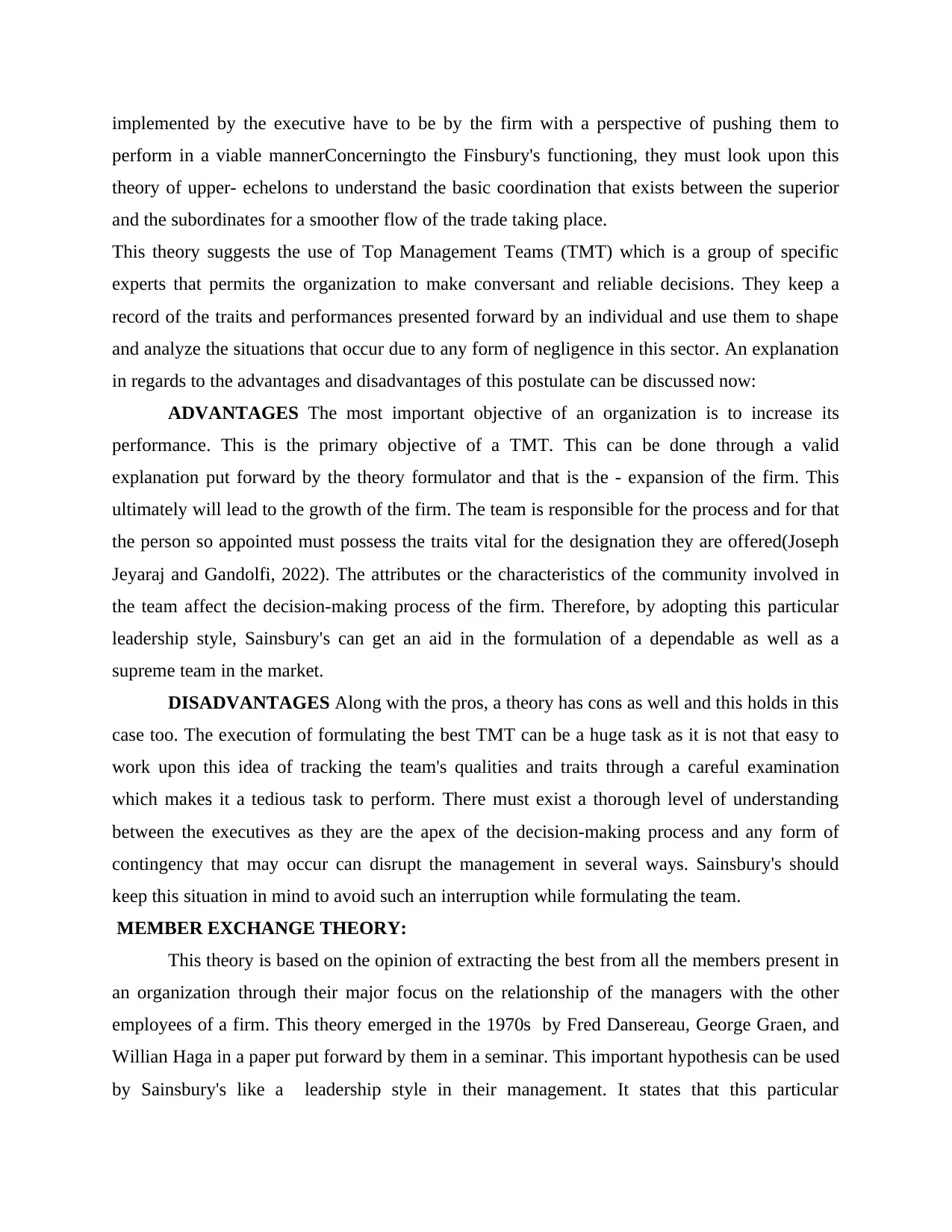
implemented by the executive have to be by the firm with a perspective of pushing them to
perform in a viable mannerConcerningto the Finsbury's functioning, they must look upon this
theory of upper- echelons to understand the basic coordination that exists between the superior
and the subordinates for a smoother flow of the trade taking place.
This theory suggests the use of Top Management Teams (TMT) which is a group of specific
experts that permits the organization to make conversant and reliable decisions. They keep a
record of the traits and performances presented forward by an individual and use them to shape
and analyze the situations that occur due to any form of negligence in this sector. An explanation
in regards to the advantages and disadvantages of this postulate can be discussed now:
ADVANTAGES The most important objective of an organization is to increase its
performance. This is the primary objective of a TMT. This can be done through a valid
explanation put forward by the theory formulator and that is the - expansion of the firm. This
ultimately will lead to the growth of the firm. The team is responsible for the process and for that
the person so appointed must possess the traits vital for the designation they are offered(Joseph
Jeyaraj and Gandolfi, 2022). The attributes or the characteristics of the community involved in
the team affect the decision-making process of the firm. Therefore, by adopting this particular
leadership style, Sainsbury's can get an aid in the formulation of a dependable as well as a
supreme team in the market.
DISADVANTAGES Along with the pros, a theory has cons as well and this holds in this
case too. The execution of formulating the best TMT can be a huge task as it is not that easy to
work upon this idea of tracking the team's qualities and traits through a careful examination
which makes it a tedious task to perform. There must exist a thorough level of understanding
between the executives as they are the apex of the decision-making process and any form of
contingency that may occur can disrupt the management in several ways. Sainsbury's should
keep this situation in mind to avoid such an interruption while formulating the team.
MEMBER EXCHANGE THEORY:
This theory is based on the opinion of extracting the best from all the members present in
an organization through their major focus on the relationship of the managers with the other
employees of a firm. This theory emerged in the 1970s by Fred Dansereau, George Graen, and
Willian Haga in a paper put forward by them in a seminar. This important hypothesis can be used
by Sainsbury's like a leadership style in their management. It states that this particular
perform in a viable mannerConcerningto the Finsbury's functioning, they must look upon this
theory of upper- echelons to understand the basic coordination that exists between the superior
and the subordinates for a smoother flow of the trade taking place.
This theory suggests the use of Top Management Teams (TMT) which is a group of specific
experts that permits the organization to make conversant and reliable decisions. They keep a
record of the traits and performances presented forward by an individual and use them to shape
and analyze the situations that occur due to any form of negligence in this sector. An explanation
in regards to the advantages and disadvantages of this postulate can be discussed now:
ADVANTAGES The most important objective of an organization is to increase its
performance. This is the primary objective of a TMT. This can be done through a valid
explanation put forward by the theory formulator and that is the - expansion of the firm. This
ultimately will lead to the growth of the firm. The team is responsible for the process and for that
the person so appointed must possess the traits vital for the designation they are offered(Joseph
Jeyaraj and Gandolfi, 2022). The attributes or the characteristics of the community involved in
the team affect the decision-making process of the firm. Therefore, by adopting this particular
leadership style, Sainsbury's can get an aid in the formulation of a dependable as well as a
supreme team in the market.
DISADVANTAGES Along with the pros, a theory has cons as well and this holds in this
case too. The execution of formulating the best TMT can be a huge task as it is not that easy to
work upon this idea of tracking the team's qualities and traits through a careful examination
which makes it a tedious task to perform. There must exist a thorough level of understanding
between the executives as they are the apex of the decision-making process and any form of
contingency that may occur can disrupt the management in several ways. Sainsbury's should
keep this situation in mind to avoid such an interruption while formulating the team.
MEMBER EXCHANGE THEORY:
This theory is based on the opinion of extracting the best from all the members present in
an organization through their major focus on the relationship of the managers with the other
employees of a firm. This theory emerged in the 1970s by Fred Dansereau, George Graen, and
Willian Haga in a paper put forward by them in a seminar. This important hypothesis can be used
by Sainsbury's like a leadership style in their management. It states that this particular
⊘ This is a preview!⊘
Do you want full access?
Subscribe today to unlock all pages.

Trusted by 1+ million students worldwide
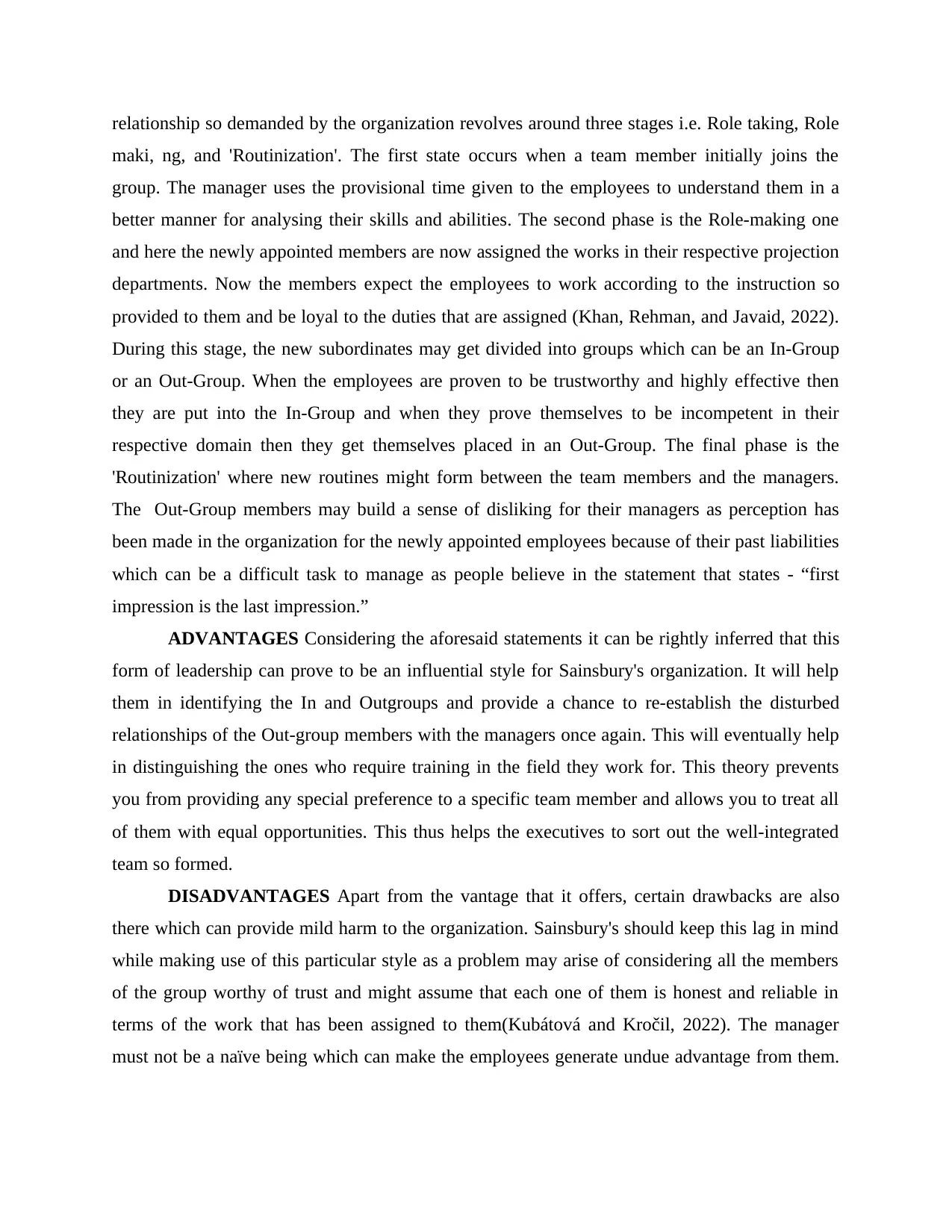
relationship so demanded by the organization revolves around three stages i.e. Role taking, Role
maki, ng, and 'Routinization'. The first state occurs when a team member initially joins the
group. The manager uses the provisional time given to the employees to understand them in a
better manner for analysing their skills and abilities. The second phase is the Role-making one
and here the newly appointed members are now assigned the works in their respective projection
departments. Now the members expect the employees to work according to the instruction so
provided to them and be loyal to the duties that are assigned (Khan, Rehman, and Javaid, 2022).
During this stage, the new subordinates may get divided into groups which can be an In-Group
or an Out-Group. When the employees are proven to be trustworthy and highly effective then
they are put into the In-Group and when they prove themselves to be incompetent in their
respective domain then they get themselves placed in an Out-Group. The final phase is the
'Routinization' where new routines might form between the team members and the managers.
The Out-Group members may build a sense of disliking for their managers as perception has
been made in the organization for the newly appointed employees because of their past liabilities
which can be a difficult task to manage as people believe in the statement that states - “first
impression is the last impression.”
ADVANTAGES Considering the aforesaid statements it can be rightly inferred that this
form of leadership can prove to be an influential style for Sainsbury's organization. It will help
them in identifying the In and Outgroups and provide a chance to re-establish the disturbed
relationships of the Out-group members with the managers once again. This will eventually help
in distinguishing the ones who require training in the field they work for. This theory prevents
you from providing any special preference to a specific team member and allows you to treat all
of them with equal opportunities. This thus helps the executives to sort out the well-integrated
team so formed.
DISADVANTAGES Apart from the vantage that it offers, certain drawbacks are also
there which can provide mild harm to the organization. Sainsbury's should keep this lag in mind
while making use of this particular style as a problem may arise of considering all the members
of the group worthy of trust and might assume that each one of them is honest and reliable in
terms of the work that has been assigned to them(Kubátová and Kročil, 2022). The manager
must not be a naïve being which can make the employees generate undue advantage from them.
maki, ng, and 'Routinization'. The first state occurs when a team member initially joins the
group. The manager uses the provisional time given to the employees to understand them in a
better manner for analysing their skills and abilities. The second phase is the Role-making one
and here the newly appointed members are now assigned the works in their respective projection
departments. Now the members expect the employees to work according to the instruction so
provided to them and be loyal to the duties that are assigned (Khan, Rehman, and Javaid, 2022).
During this stage, the new subordinates may get divided into groups which can be an In-Group
or an Out-Group. When the employees are proven to be trustworthy and highly effective then
they are put into the In-Group and when they prove themselves to be incompetent in their
respective domain then they get themselves placed in an Out-Group. The final phase is the
'Routinization' where new routines might form between the team members and the managers.
The Out-Group members may build a sense of disliking for their managers as perception has
been made in the organization for the newly appointed employees because of their past liabilities
which can be a difficult task to manage as people believe in the statement that states - “first
impression is the last impression.”
ADVANTAGES Considering the aforesaid statements it can be rightly inferred that this
form of leadership can prove to be an influential style for Sainsbury's organization. It will help
them in identifying the In and Outgroups and provide a chance to re-establish the disturbed
relationships of the Out-group members with the managers once again. This will eventually help
in distinguishing the ones who require training in the field they work for. This theory prevents
you from providing any special preference to a specific team member and allows you to treat all
of them with equal opportunities. This thus helps the executives to sort out the well-integrated
team so formed.
DISADVANTAGES Apart from the vantage that it offers, certain drawbacks are also
there which can provide mild harm to the organization. Sainsbury's should keep this lag in mind
while making use of this particular style as a problem may arise of considering all the members
of the group worthy of trust and might assume that each one of them is honest and reliable in
terms of the work that has been assigned to them(Kubátová and Kročil, 2022). The manager
must not be a naïve being which can make the employees generate undue advantage from them.
Paraphrase This Document
Need a fresh take? Get an instant paraphrase of this document with our AI Paraphraser
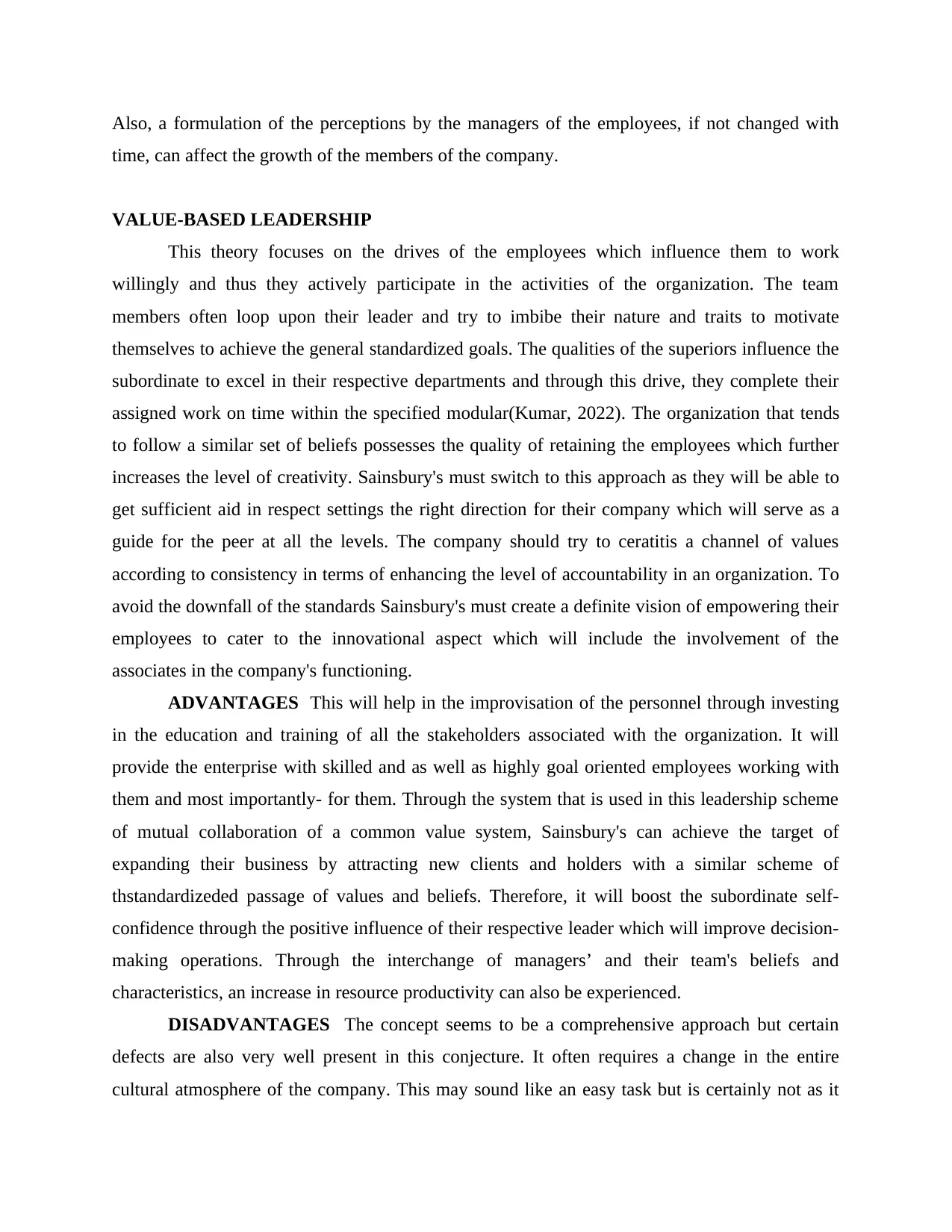
Also, a formulation of the perceptions by the managers of the employees, if not changed with
time, can affect the growth of the members of the company.
VALUE-BASED LEADERSHIP
This theory focuses on the drives of the employees which influence them to work
willingly and thus they actively participate in the activities of the organization. The team
members often loop upon their leader and try to imbibe their nature and traits to motivate
themselves to achieve the general standardized goals. The qualities of the superiors influence the
subordinate to excel in their respective departments and through this drive, they complete their
assigned work on time within the specified modular(Kumar, 2022). The organization that tends
to follow a similar set of beliefs possesses the quality of retaining the employees which further
increases the level of creativity. Sainsbury's must switch to this approach as they will be able to
get sufficient aid in respect settings the right direction for their company which will serve as a
guide for the peer at all the levels. The company should try to ceratitis a channel of values
according to consistency in terms of enhancing the level of accountability in an organization. To
avoid the downfall of the standards Sainsbury's must create a definite vision of empowering their
employees to cater to the innovational aspect which will include the involvement of the
associates in the company's functioning.
ADVANTAGES This will help in the improvisation of the personnel through investing
in the education and training of all the stakeholders associated with the organization. It will
provide the enterprise with skilled and as well as highly goal oriented employees working with
them and most importantly- for them. Through the system that is used in this leadership scheme
of mutual collaboration of a common value system, Sainsbury's can achieve the target of
expanding their business by attracting new clients and holders with a similar scheme of
thstandardizeded passage of values and beliefs. Therefore, it will boost the subordinate self-
confidence through the positive influence of their respective leader which will improve decision-
making operations. Through the interchange of managers’ and their team's beliefs and
characteristics, an increase in resource productivity can also be experienced.
DISADVANTAGES The concept seems to be a comprehensive approach but certain
defects are also very well present in this conjecture. It often requires a change in the entire
cultural atmosphere of the company. This may sound like an easy task but is certainly not as it
time, can affect the growth of the members of the company.
VALUE-BASED LEADERSHIP
This theory focuses on the drives of the employees which influence them to work
willingly and thus they actively participate in the activities of the organization. The team
members often loop upon their leader and try to imbibe their nature and traits to motivate
themselves to achieve the general standardized goals. The qualities of the superiors influence the
subordinate to excel in their respective departments and through this drive, they complete their
assigned work on time within the specified modular(Kumar, 2022). The organization that tends
to follow a similar set of beliefs possesses the quality of retaining the employees which further
increases the level of creativity. Sainsbury's must switch to this approach as they will be able to
get sufficient aid in respect settings the right direction for their company which will serve as a
guide for the peer at all the levels. The company should try to ceratitis a channel of values
according to consistency in terms of enhancing the level of accountability in an organization. To
avoid the downfall of the standards Sainsbury's must create a definite vision of empowering their
employees to cater to the innovational aspect which will include the involvement of the
associates in the company's functioning.
ADVANTAGES This will help in the improvisation of the personnel through investing
in the education and training of all the stakeholders associated with the organization. It will
provide the enterprise with skilled and as well as highly goal oriented employees working with
them and most importantly- for them. Through the system that is used in this leadership scheme
of mutual collaboration of a common value system, Sainsbury's can achieve the target of
expanding their business by attracting new clients and holders with a similar scheme of
thstandardizeded passage of values and beliefs. Therefore, it will boost the subordinate self-
confidence through the positive influence of their respective leader which will improve decision-
making operations. Through the interchange of managers’ and their team's beliefs and
characteristics, an increase in resource productivity can also be experienced.
DISADVANTAGES The concept seems to be a comprehensive approach but certain
defects are also very well present in this conjecture. It often requires a change in the entire
cultural atmosphere of the company. This may sound like an easy task but is certainly not as it
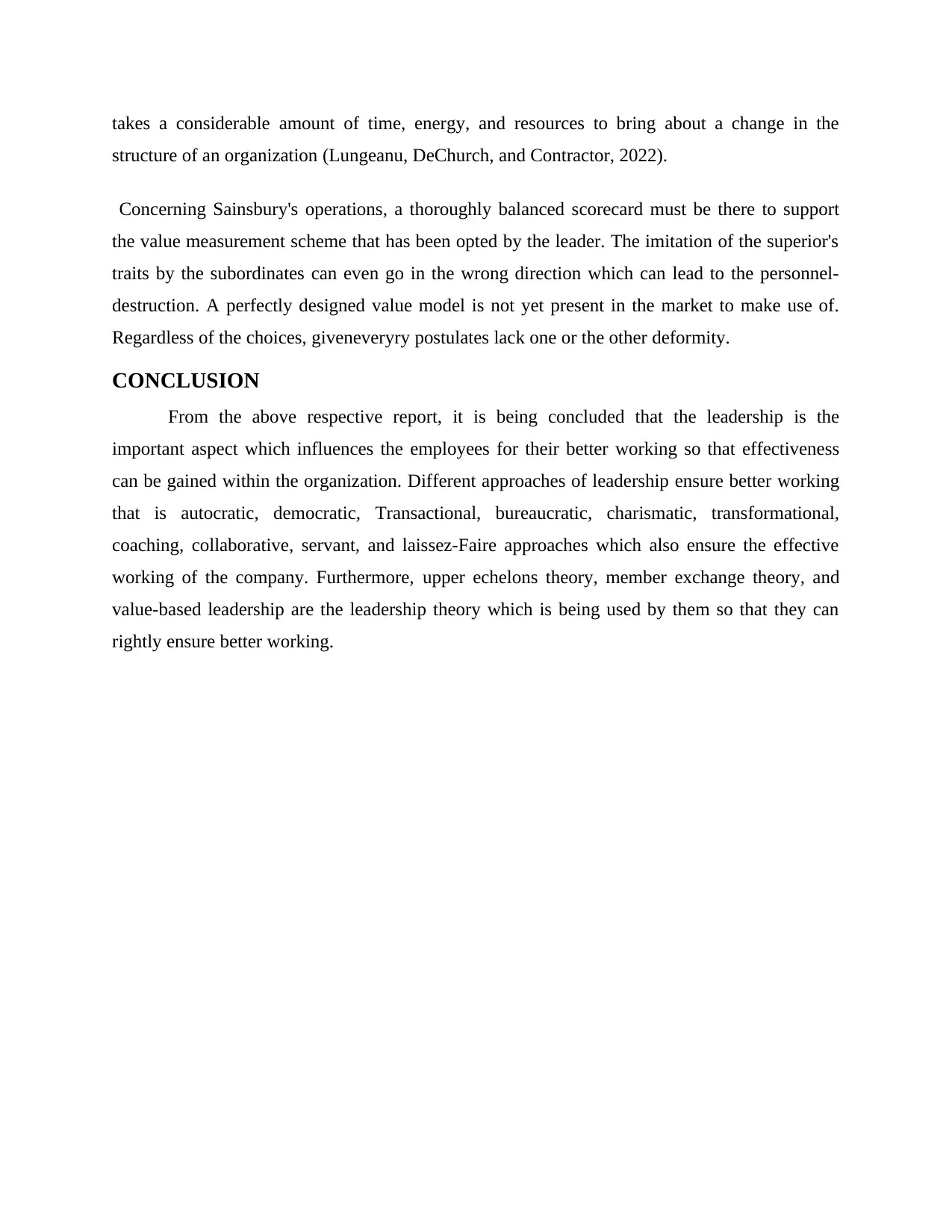
takes a considerable amount of time, energy, and resources to bring about a change in the
structure of an organization (Lungeanu, DeChurch, and Contractor, 2022).
Concerning Sainsbury's operations, a thoroughly balanced scorecard must be there to support
the value measurement scheme that has been opted by the leader. The imitation of the superior's
traits by the subordinates can even go in the wrong direction which can lead to the personnel-
destruction. A perfectly designed value model is not yet present in the market to make use of.
Regardless of the choices, giveneveryry postulates lack one or the other deformity.
CONCLUSION
From the above respective report, it is being concluded that the leadership is the
important aspect which influences the employees for their better working so that effectiveness
can be gained within the organization. Different approaches of leadership ensure better working
that is autocratic, democratic, Transactional, bureaucratic, charismatic, transformational,
coaching, collaborative, servant, and laissez-Faire approaches which also ensure the effective
working of the company. Furthermore, upper echelons theory, member exchange theory, and
value-based leadership are the leadership theory which is being used by them so that they can
rightly ensure better working.
structure of an organization (Lungeanu, DeChurch, and Contractor, 2022).
Concerning Sainsbury's operations, a thoroughly balanced scorecard must be there to support
the value measurement scheme that has been opted by the leader. The imitation of the superior's
traits by the subordinates can even go in the wrong direction which can lead to the personnel-
destruction. A perfectly designed value model is not yet present in the market to make use of.
Regardless of the choices, giveneveryry postulates lack one or the other deformity.
CONCLUSION
From the above respective report, it is being concluded that the leadership is the
important aspect which influences the employees for their better working so that effectiveness
can be gained within the organization. Different approaches of leadership ensure better working
that is autocratic, democratic, Transactional, bureaucratic, charismatic, transformational,
coaching, collaborative, servant, and laissez-Faire approaches which also ensure the effective
working of the company. Furthermore, upper echelons theory, member exchange theory, and
value-based leadership are the leadership theory which is being used by them so that they can
rightly ensure better working.
⊘ This is a preview!⊘
Do you want full access?
Subscribe today to unlock all pages.

Trusted by 1+ million students worldwide
1 out of 15
Your All-in-One AI-Powered Toolkit for Academic Success.
+13062052269
info@desklib.com
Available 24*7 on WhatsApp / Email
![[object Object]](/_next/static/media/star-bottom.7253800d.svg)
Unlock your academic potential
Copyright © 2020–2025 A2Z Services. All Rights Reserved. Developed and managed by ZUCOL.
